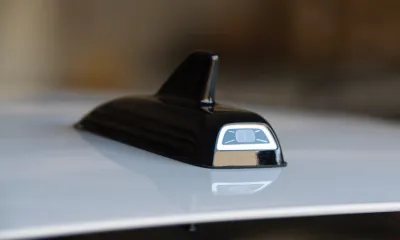I was very excited to have led an outstanding panel at the Covesa conference in Dearborn this past October on the vehicle in-cabin evolution. The panel brought together experts from tech companies and automakers to discuss how to orchestrate technology in vehicle interior design. The panel was called “In-Cabin Choreography” and the panelists were Steve Higgins from Google, Dan Cashen from Stellantis, and Soyeon Choi from Ultifi Design (part of GM). Together they brought a vast array on knowledge and insights from the current roles and their rich histories. As a bellwether of the speed of change, the oldest logo among the four of us is “Google.”

The panel premise was whether, with technology changing so quickly and coming into the fray from so many different sources, we could envision some "rules of the road" for coordinating it all to create the best user experience in the cabin, focusing on the ultimate end users: the drivers and passengers. While I had a battery of excellent questions, as you can imagine with a group this diverse and informed, and a packed audience, each question brought vibrant discussions and we ran out of time before we’d gotten more than a few questions in. Hence, we’ll talk about just two of the questions here.
Do Customers Know What They Want?
One of the questions was whether customers know what they want. The consensus among the panelists was that, while they have needs, their ability to be self-aware of those needs and then further convey those needs accurately is limited. Worse still is their ability to visualize how a certain technology could address those needs. And at the bottom of the likelihood totem pole is that they could completely connect all the dots from:
1. being self-aware of a need,
2. being able to convey that need,
3. conveying what kind of technology would address that need, and
4. describing how it should be deployed.
That means that vehicle cabin designers could face gaps in human factors insights, and may have to fill those based on past experience or intuition, particularly with new technology with no baseline for comparison. And of course, that’s not always the dominant driver of cabin decisions. Sometimes technology is added in the hope that customers will think it’s cool or cutting edge, and so drive sales. Sometimes it’s about keeping up the Jones whether or not the Jones experience has merit: they have six in-cabin monitors, so we need six as well.
How Much In-Cabin Technology is Actually Used by Customers?
Another of the questions was somewhat fall-out from the first: what percent of in-cabin technology do drivers actually use? The answer: about 1%. Granted that answer was somewhat tongue-in-cheek, but directionally the answer is likely much closer to 1% than to 100%. For the sake of discussion, we’ll say consumer actively use 20% of in-cabin technology.
Here’s a real-world example: my vehicle has a button to change the traction algorithm with settings like “normal,” “sand,” “mud” and “snow.” I played with it once just to see whether it worked and what lights appeared on the dashboard but have never actually used the feature even though I live in a snowy area (I have full-time AWD).

Does that mean that the 80% of unused technology is a waste of investment by suppliers and OEMs? Some of it absolutely yes. But some of it, even if not used, may drive a sale (that’s called “option value” in economic terms). The more complex manifestation is that the 20% may be a different mix of cabin technology for each driver. We’re all different, and so our technology desires and choices may be different. My 20% may only partially overlap with your 20%, and so on. Hence the collection of total use across everyone’s 20% (think of a Venn diagram) could be, say, 75%, leaving 25% unused by anyone.
That 25% of unloved and unused technology in vehicle cabins costs money and time to develop and deploy that will never be recovered. That cuts into the bottom line. Then there’s the ancillary impact on driver UX (user experience). Let’s say I like an infotainment feature in my vehicle. That’s a potential for customer delight. But if I have to wade through several menus to get to that feature—menus needed to be able to access the technology I don’t want—then I might become frustrated. That can be helped by smart UI menus but only if the smartness is truly smart itself and doesn't do more damage than good.
Or worse, I never find the technology in the first place, so don’t ever use it and certainly don’t evangelize it. Pulse has done several studies measuring how well a certain functionality in a driver's vehicle works, and we often find that the drivers themselves (they drive their own vehicles) don’t even know a capability exists in their own vehicles. Sometimes they're unaware it's there, sometimes they had no interest in exploring it, sometimes they do the same thing in alternative ways--such as via their smartphone.
One Big Honkin' HMI...Or a Cabin of Chaos?
In today’s world, the vehicle cabin is one giant HMI—Human Machine Interface—and the user experience tied to that needs to be studied by looking at both the whole and the parts. Some forward-thinking OEMs and auto suppliers are already thinking that way. Some aren’t past the UI—user interface—level yet or don’t embrace the difference between UI and UX. The former are the ones that will be best positioned to optimize the experience, which will save money, speed development, and create better user experiences all at the same time. The latter may end up continuing to throw things into the pot, risking a cabin of chaos at the expense of customer delight.

Ultimately, the cabin may become a hybrid of surfaced consumer needs, cabin and technology designer savvy, technological capabilities, benchmarking rivals and of course cost. Success will come with the right balance of those.
In closing, as you explore the intersection of people and technology in the coming months, think about those two elements: (1) assume consumers have needs but can’t really tell you want they want and (2) strive to avoid unnecessary technology saturation that ultimately costs money and adds little to the customer experience. Those are two of the many reasons our automotive customers use our Pulse Labs In-Car CameraTM (ICC) suite of products. And it’s the same reason our technology customers use our Smart Tech CameraTM(STC) suite of products. We’re experts in the field and we find new insights every day, and our solutions apply across the product lifecycle.
Pulse Labs (https://pulselabs.ai/) is a pioneering business insights company that specializes in turning human factors analyses and behavioral information into actionable results for our customers. Our proprietary data processes mean speed and accuracy. Our Power PortalTM ensures that decision-makers have quick and ongoing access to results to increase their competitiveness. Our customer set includes innovators such as leading technology platforms, top brands and government agencies. For more information, visit https://pulselabs.ai.




